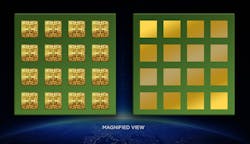Gain Efficiency with Fragmented-Aperture Phased Arrays
This article appeared in Microwaves & RF and has been published here with permission.
What you’ll learn:
- Electronically steered arrays are essential in next-gen satellite constellations.
- Fragmented-aperture technology overcomes limitations of traditional monolithic radiating elements.
- Aperture efficiency drives technical, operational, and commercial performance.
The world’s demand for broadband connectivity has created a new generation of high-throughput satellites in geosynchronous Earth orbit (GEO), medium Earth orbit (MEO), and now low Earth orbit (LEO). But technology innovation in the ground segment has struggled to catch up to the space segment, especially when it comes to developing the most elusive of all antennas: Those that are low-cost and electronically steerable to power these next-generation, lower-orbit satellite networks.
Electronically steerable antennas (ESAs), often referred to as flat panels, are the critical link for next-generation constellations. Compared with their bulkier mechanical cousins, flat-panel antennas offer greater efficiency and performance while being modular and dynamically steerable—all of which are needed for the future ground segment.
While ESAs’ flat and conformal characteristics can have aesthetic benefits, the real benefit comes from their performance. LEO and MEO satellites require the ability to track and communicate with two or more satellites in view at the same time, and this can only be done with multiple mechanical antennas. With no moving parts, ESAs are more reliable and efficient as they can connect to multiple satellites at the same time. This gives a single ESA the ability to interoperate with multiple orbits—not just GEOs.
Such next-generation antennas are vital to making inroads into the mass-consumer connectivity market, but the first users, everyone agrees, will come from the commercial and defense mobility markets.
Ground Segment Growth
NSR, a market research and consulting firm, estimates that cumulative revenues for the entire ground segment through 2028 will total $145 billion. The market will generate $14.4 billion annually by 2028, the firm states in its recent report, Commercial Satellite Ground Segment, 4th Edition (CSGS4). The user terminal will command a substantial portion of this spend.
In Search of the Holy Grail of ESAs
Given the importance of these terminals, how are antenna developers tackling the ESA challenge from an architecture perspective, and when will this technology be accessible on broadband networks?
Many different approaches can be taken to develop next-generation flat-panel antennas. All consist of small antennas, known as radiating elements, and both receive- and transmit-side amplification. From here, broadly speaking, these can be categorized as passive or active antennas.
A passive antenna takes one signal from the power amplifier (PA) on the transmit side and divides this signal out to the transmit radiating elements, then combines the receive signals from the radiating elements before feeding the receive-side low-noise amplifier (LNA). An active antenna, in contrast, has a single amplifier per radiating element, for both transmit (TX) and receive (RX). In general, passive antennas are less complex, while active antennas provide greater gain performance.
Next, we need to look at how the signal paths are formed, where either analog or digital beamforming are applicable. New materials, from improved RFICs to custom ASICs to lenses, provide many ways to solve this challenge. But all of these new approaches require invention, development effort, and time before they are likely to be deployed in the field.
Much of the recent development has gone into the back of the antenna—how beams are formed, how one develops better RFICs, and so on. However, not much innovation capital has been invested in the front side itself, known as the radiating elements.
NXTCOMM’s antenna leverage fragmented-aperture technology, the result of decades of defense R&D investment and collaboration with the its technical research partner, Georgia Tech Research Institute. The company’s phased-array antenna design focuses on more efficient radiating elements to improve the portion of the antenna facing the satellite.
More Efficient Radiating Elements
Traditional radiating-element design takes a monolithic approach—namely, a single circle of copper, a square, a trapezoidal solid, or an iron cross. These radiators are then stepped and repeated around the array to meet the required gain for the use case.
One limitation is that those shapes can contribute to a reduction in gain by causing parasitic coupling. Simply put, one element close to another can interfere with its neighbor. The more elements in the array, the greater the parasitic coupling, and the lower the efficiency. This interference impacts gain in general but can also lead to undesirable grating lobes, and perhaps contribute to an undesirable antenna pattern, especially on the transmit side. These elements may also be resonant structures, limiting the antenna’s overall frequency.
Such factors negatively impact the overall efficiency of the aperture. Typical antennas using these radiating elements achieve an aperture efficiency of 60% to 70% when scaled up to a size appropriate for satellite communications.
In a fragmented aperture, the radiating element isn’t a single piece of copper. Instead, it’s pixelated, like an array within an array (Fig. 1). Such an approach not only helps reduce the parasitic coupling between elements, but it also helps increase gain and improve sidelobe performance.
In addition, the fragmented-aperture architecture allows for significantly greater antenna bandwidth. Because the elements aren’t inherently resonant structures, they can be designed to cover very wide bandwidths. This flexibility is particularly important in the emerging LEO use case as the antenna needs to target multiple satellites simultaneously, requiring use of different ranges within the frequency band.
Wideband Frequency Coverage
The fragmented-aperture approach can support bandwidths of up to 100:1 and typically 33:1. In the bands of interest for satellite communications, fragmented-aperture flat panels support the entire Ku-band (10.7 GHz to 14.75 GHz) or even the Ka-band (17.2 GHz to 30 GHz) with a single element, making it possible to use a single antenna across a wide range of satellite networks.
In terms of aperture efficiency, these antennas achieve efficiencies in the 85% to 90% range when scaled up to a size suitable for satellite communications. When compared in terms of aperture efficiency, a fragmented-aperture antenna array achieves efficiency of 80% to 90% while a traditional square-element antenna array delivers efficiency of 60% to 70% (Fig. 2).
Better Efficiency Means Better Performance
Increased efficiency at the satellite-facing side of the antenna improves overall system performance. The greater the gain, the lower the power consumption of the antenna system. With lower power consumption comes the added benefit of less heat to dissipate.
NXTCOMM’s approach combines the fragmented aperture with an active phased-array architecture. Traditional active arrays have been known to be very power-hungry and to require exotic cooling. These two unwanted artifacts are significantly decreased by adopting this approach.
Making the antenna more efficient at the RF layer also makes it more efficient to manufacture. NXTCOMM’s fragmented-aperture antenna can be built on a single printed circuit board (PCB), reducing part count and complexity and making the overall antenna less costly. Elements comprise subarrays, and subarrays comprise complete antenna arrays (Fig. 3).
To fulfill the potential of the new reality of the LEO mega-constellations, the user terminal is key. The industry needs to look for well-proven technology that can be delivered on time and to the scale required to bring high-speed connectivity to the underserved, as well as unlock full broadband on-the-move in mobility markets.
References
NXTCOMM/GTRI Antenna Design Collaboration
NXTCOMM AeroMax Antenna Announcement
NXTCOMM Blog Q&A: Meet Carl Novello, NXTCOMM’s New CTO
Patent: CITE Fragmented aperture antennas and broadband antenna ground planes US6323809B1
“New Design Creates Ultra Wideband Antenna,” Georgia Tech News
About the Author
Carl Novello
Chief Technology Officer, NXT Communications Corp.
Carl Novello is the Chief Technical Officer for NXT Communications (NXTCOMM), a Georgia-based provider of mobile broadband connectivity products and services. He oversees product engineering, design, and test development for NXTCOMM’s line of advanced electronically steered antennas. A 20-year satellite antenna technology veteran, Carl has extensive industry experience leading a wide range of antennas focused on the mobile marketplace.



